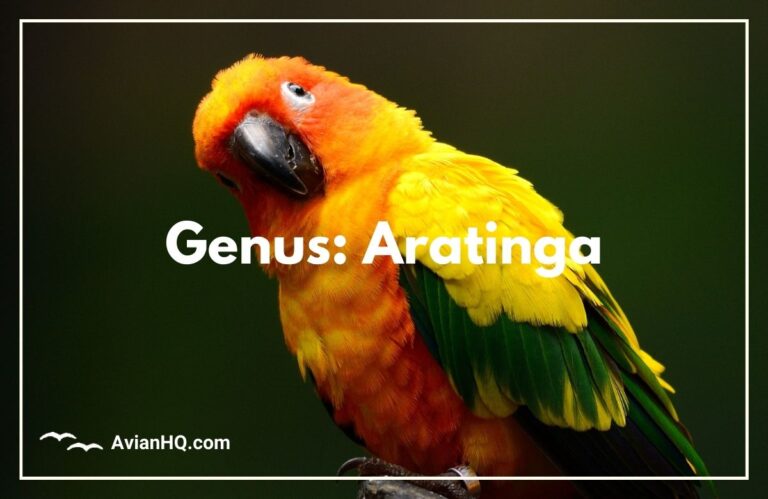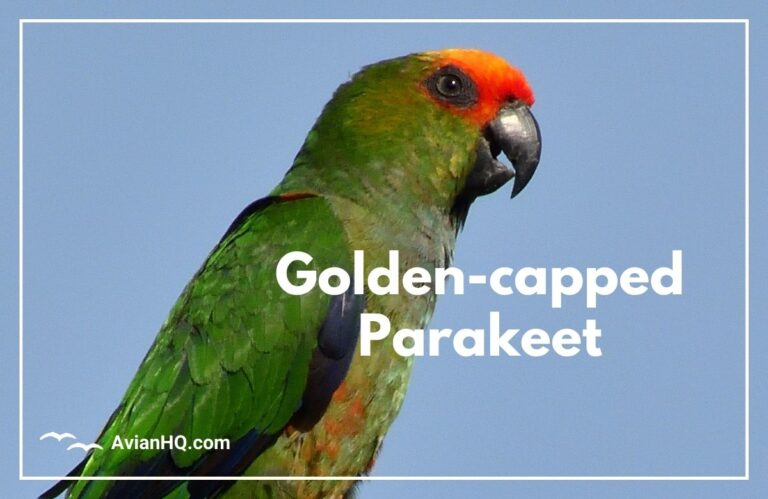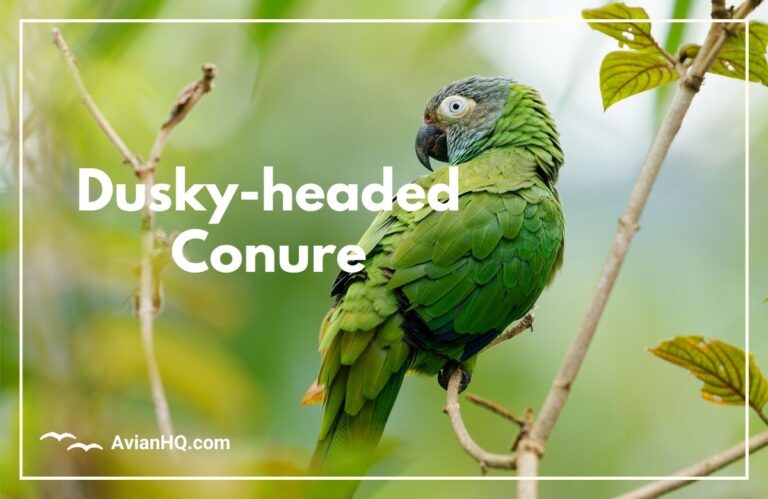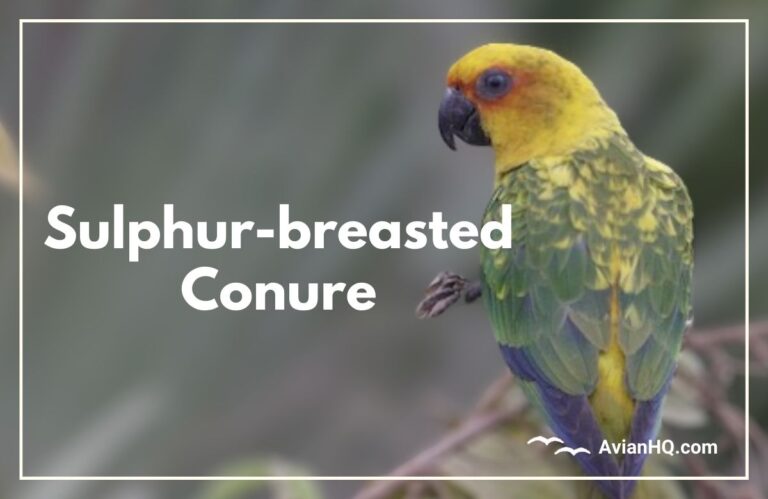Nanday Conure (Aratinga nenday)
The Nanday Conure (Aratinga nenday) stands out with its bright green, yellow, blue and black plumage. If you’re looking for a small parrot with a big personality, this South American native may be the right fit.
With proper care, these little parrots can live 15-20 years. Their medium size – 13 to 14 inches (33 to 36 cm) long – and lack of extremely loud vocalizations makes them suitable for apartments or houses. Nanday Conures can learn tricks and words, though their speaking ability remains limited compared to larger parrot species.
These birds thrive when kept active. Provide plenty of safe toys to chew on and climb on. Supervise their out-of-cage playtime daily. With attention and enrichment, the Nanday Conure makes a delightful pet bird.
In this comprehensive guide, you’ll learn all about the natural history of Nanday Conures as well as their care requirements, behavior, and suitability as companion parrots. Discover what makes this eye-catching parakeet unique.
History and Taxonomy
The Nanday Conure entered the scientific literature in 1837 when German naturalist Johann Georg Wagler first described the species. He assigned it to the genus Aratinga, a group of small to medium-sized New World parrots.
This parrot’s common name comes from the Guaraní tribe of Paraguay. Nenday or Ñanday means “I shine” or “giving off light” in the Guaraní language. This likely refers to the conure’s brightly colored feathers.
Scientific Classification
The Nanday Conure belongs to the following taxonomic classification:
- Kingdom: Animalia
- Phylum: Chordata
- Class: Aves
- Order: Psittaciformes
- Family: Psittacidae
- Genus: Aratinga
- Species: A. nenday
Its scientific name breaks down into two parts. Aratinga refers to the genus of small to medium sized parrots that the Nanday belongs to. Nenday comes from the Guaraní name.
No subspecies of the Nanday Conure have been recognized. Unlike some other Aratinga species, the Nanday’s bright coloration remains consistent across its range without major geographic variations.
Physical Appearance
The Nanday Conure measures 13 to 14 inches (33 to 36 cm) long from beak tip to tail tip. It weighs between 100 to 150 grams on average. This places it on the larger end of conures and small parrots in terms of size.
Vibrant Plumage
This parrot sports vibrant multicolored plumage. Its primary body feathers shine bright green above with a lighter green-yellow hue below. The head shows rich dark blue feathers along with some black marking the face. The breast also bears some black scalloping.
White edging outlines the Nanday’s wing coverts in neat rows when the wings fold closed. The tail feathers display a mix of green and deep blue. Some bright yellow often occurs on the thigh feathers and vent. The bill, eyes, and feet all show a horn colored appearance.
Male and female Nandays have identical external appearance with no sexual dimorphism in their plumage. Juveniles look similar but show less vibrant colors on their initial feathers. Their irises also start out gray before changing to dark brown.
Anatomy
The Nanday possesses typical parrot anatomy. Its strong curved bill easily cracks hard nuts and seeds. The zygodactyl foot configuration features two toes facing forward and two facing backward for excellent gripping ability.
Long wing bones give the Nanday strong flight capabilities over long distances. Its prehensile tail feathers allow it to brace against perches. Overall an agile and athletic small parrot.
Habitat and Distribution
The Nanday Conure naturally occurs in central South America across parts of Brazil, Bolivia, Paraguay and Argentina. Its range centers mainly on the Gran Chaco region, a large savanna ecoregion extending through multiple countries.
Native Habitat
This parrot primarily inhabits open woodlands or palm groves known as palm savannas within its native range. It seems to prefer drier thorn forest habitats over wetter rainforest regions. Nandays also appear in grasslands, farms, and sometimes urban areas.
Their elevation range stretches up to 1,300 meters (4,250 feet) in the Andean foothills. But most sightings occur below 500 meters (1,600 feet). Within their habitat, Nanday Conures roost and nest in tree cavities.
Introduced Populations
The pet trade has introduced feral Nanday Conure populations to areas outside South America. Small groups have become established in Florida, California, Hawaii, and Puerto Rico after either escaping or getting released. These introductions bring concerns of potential crop damage or displacing native species. For now though, most of these populations remain small.
So far the Nanday has not appeared as extensively invasive as the highly successful Monk Parakeet, another South American parrot. But experts recommend monitoring and controlling any spread of the Nanday Conure outside its natural range.
Diet and Feeding
The Nanday Conure eats a varied omnivorous diet in the wild. It forages for different foods depending on seasonal availability within its habitat.
Natural Diet
This parakeet’s diet consists predominantly of plant matter. Important staples include nuts, seeds, fruits, berries, buds, and vegetables. Common favorites include palm nuts, acuri nuts, corn kernels, cactus fruits, figs, and celery-like plants.
Nandays supplement their herbivorous diet with some animal protein when available. They occasionally eat insects and insect larvae, snails, small lizards or frogs and bird eggs snatched from nests. But vegetation likely makes up over 90% of their total diet.
Feeding Behaviors
Nanday Conures exhibit robust foraging behaviors thanks to their strong bills and feet. These parrots use their curved beaks like a can opener to get into tough palm nuts. Their nimble toes provide a sure grip on tree branches and vines.
Flocks forage actively in the morning and late afternoon hours. They move both through high forest canopies and down to the ground searching for food items. At favored feeding grounds, disputes over resources sometimes occur between flock members or other bird species.
In captivity, Nandays should receive a nutritious prepared pellet diet supplemented with healthy human foods like fresh vegetables and limited fruits. Always give them access to clean drinking water. Rotate different toys and foraging activities to exercise their agile beaks and feet. Proper nutrition and hydration supports both physical and mental health.
Breeding and Reproduction
In the wild, Nanday Conures reach sexual maturity and begin breeding around 2-4 years of age. The breeding season aligns with the rainy period between October and February in their South American habitat.
Nest Sites
Nandays nest in tree cavities, either natural hollows or old woodpecker holes. Competition occurs for the best nest sites. Originally monogamous pairs will defend potential nesting sites from other Nandays or bird species. They may enlarge the cavity entrance or line the interior with wood chips.
Clutches and Incubation
The female Nanday lays a clutch of 3-6 white eggs. She incubates them herself for 24-25 days while the male provides food. Some sources report the male participating in incubating duties as well.
Hatchlings emerge with sparse white down. Both parents feed and care for the altricial young. After 8 weeks, the juveniles appear fully feathered and ready to leave the nest.
Rearing Chicks
In captive breeding, hand raising Nanday chicks requires skill and intensive effort. The tiny hatchlings need feedings every 1-2 hours and a brooder temperature around 95°F (35°C). Many breeders choose to allow the parents to raise their offspring instead. Parent-raised chicks still need proper nutrition and regular weigh-ins for their first months.
With commitment, Nanday Conure breeding can succeed to increase their captive population. But only experienced owners should attempt hand feeding such delicate parrot babies by following reputable guidance.
Behavior and Ecology
The Nanday Conure exhibits highly social behaviors as part of flocks out in the wild. They form strong bonds with flock mates that may last for life.
Flock Dynamics
Nandays live in large communal flocks most of the year. The average flock size consists of 10 to 30 individuals. But some groups may number over 100 birds congregating at plentiful feeding areas.
Flocks roost together at night in cavities of tall palm trees or other large trees. Their bright green plumage blends into the vegetation to hide from potential predators. During the day, the flock breaks into small foraging groups to search for food.
Vocalizations
These highly vocal parrots use loud, screechy calls to communicate within the flock. Their contact calls sound like “nee-ahh” or rolling “kyoww” cries. They make even louder alarm calls when disturbed by predators like hawks or mammals.
In captivity, Nandays should also be housed with or near another bird companion. Without adequate social bonding and mental enrichment, they may scream loudly or self-mutilate out of stress or boredom.
Interactions with Other Species
Various species intermingle with Nanday flocks in the wild. Monk Parakeets frequently associate with them when feeding. Other parrot relatives like macaws may also congregate, though Nandays tend to remain separate when breeding.
Small songbirds often nest near them for added protection. But Nandays sometimes raid songbird nests for eggs and chicks. Overall these adaptable parrots fit well into their eclectic habitat when resources remain plentiful.
Conservation Status
The Nanday Conure has an extensive range across central South America. Its global population likely exceeds 1 million individuals. As a result, the IUCN Red List categorizes it as a species of Least Concern.
Population Trends
No overall population declines have been reported for the Nanday Conure. In fact, some evidence points to increasing numbers taking advantage of deforested land converted to agricultural sites in regions like the Gran Chaco. They may prosper in these newly opened habitats.
Local declines are possible though in specific areas. Paraguayan ecology surveys found Nanday numbers reduced in certain locations over 1-2 decades for habitat destruction. But other spots showed more conures in altered human landscapes.
Trapping and Trade
Some illegal trapping of wild Nandays feeds demand for the pet trade, one factor that could lower their numbers locally. One estimate claimed 150,000 conures exported illegally from Paraguay alone in 2002. But the full impact on populations remains undetermined so far.
In recent years, efforts made to register captive bred birds may help discourage excessive removal from the wild. However, better monitoring and stricter law enforcement could provide a boost to conserve both habitat and species in the regions they originate. For now, the adaptable Nanday Conure population appears stable without need for protections.
Cultural Significance
The vibrant colors and vocal nature of the Nanday Conure have attracted human attention for centuries. Indigenous peoples revered these flashy parrots in myth traditions and incorporated them into cultural symbols. More recently pet lovers and aviculturalists developed a strong captivation for the Nanday as well.
Native Traditions
For the Guaraní people, the Ñanday represented the god Ñanderuvusu and his life-sustaining solar power associated with maize. They also viewed this talkative bird as spreading gossip between villages. Some tribes may have kept them as pets or used their bright feathers for ceremonial costumes.
Other indigenous artisans crafted flutes out of Nanday wing bones. The Chaco tribe performed a Nanday dance dressed in blue, black, green, and yellow costumes echoing the bird’s colors. Tribal legends warned disobeying youths they could transform into noisy Nandays! This cultural significance shows its esteemed status.
Captive Popularity
Since becoming established in aviculture over a century ago, the Nanday Conure continues as a mainstay pet trade bird globally. Their attractive colors, playful nature, medium size, and lack of extreme noise appeals to parrot enthusiasts.
Nandays sometimes appear in movies, television, or print media as iconic parrot representatives. Conservation minded owners and breeders also work to preserve captive genetic diversity for the future. Thanks to its likeable qualities and cultural heritage, this eye-catching parakeet maintains longtime appreciation.
Conclusion
The Nanday Conure stands out as one of the most colorful and charismatic small parrots of South America. This medium-sized parakeet measures 13 to 14 inches (33 to 36 cm) long and shows bright plumage of green, blue, yellow and black.
Native to central regions of the continent, Nanday Conures thrive in open habitats like palm savannas and agricultural areas. They live very socially in large flocks of 10 to 30 birds on average. Their loud contact calls reverberate as they forage for plant foods and roost communally in trees.
While not currently threatened, some illegal trapping for the pet trade may impact local wild populations. But well-cared for captive birds continue a long history of esteem by indigenous cultures and modern parrot enthusiasts.
If seeking a small parrot as a pet, the hardy and flashy Nanday Conure makes an excellent companion. Their moderate noise levels, playful antics, and ability to learn tricks suits them for households or apartments. Just be sure to provide plenty of space, toys, healthy foods and social bonding for these active flock dwellers. When their needs get met, the Nanday’s beautiful colors and lively personality shine through!







